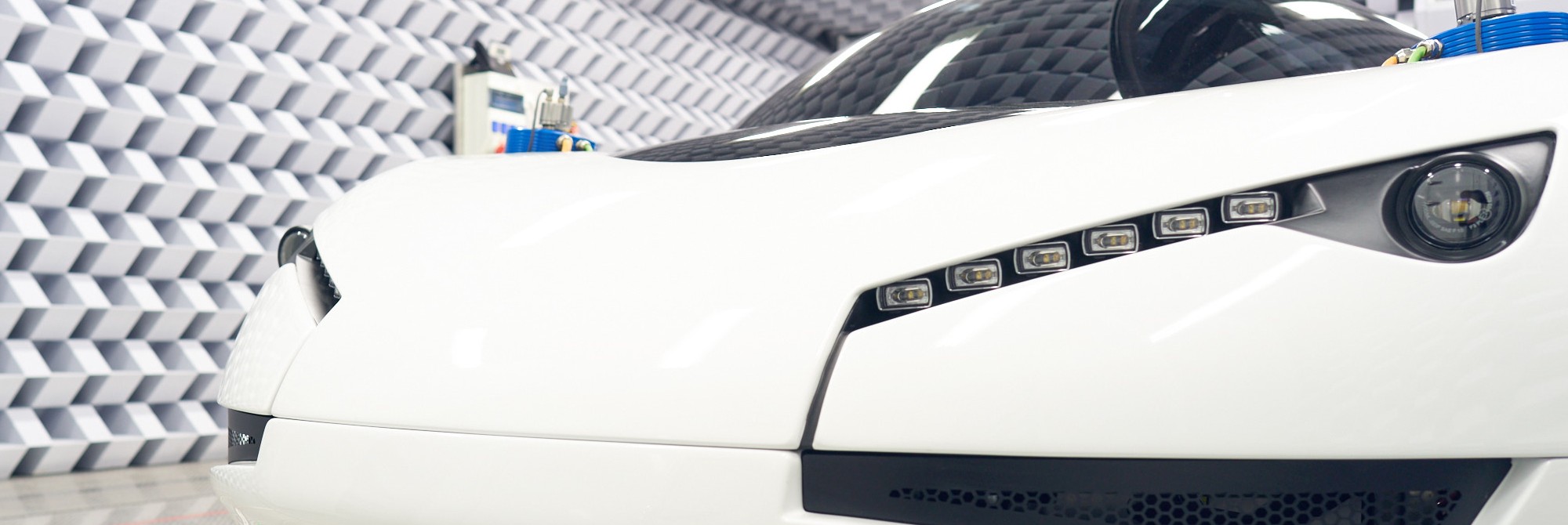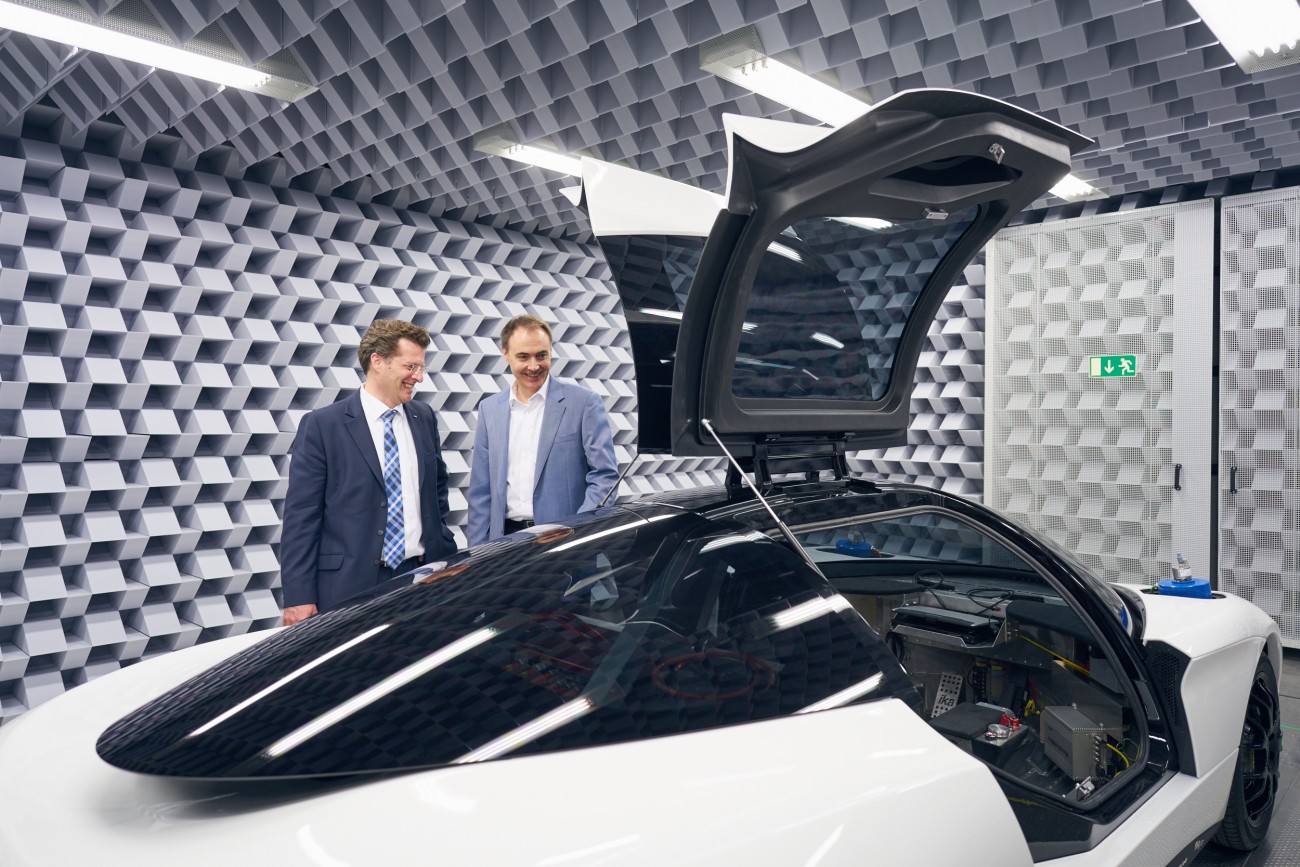E-mobility shows the way forward – Lutz Eckstein, Director of the Institute for Automotive Engineering (ika) in Aachen and Lothar Patberg, head of Innovation at Steel, on innovative materials, modern technologies and a new driving experience.
(Interview: Judy Born)
What are the challenges for creating the car of the future?
Eckstein: First of all, it is necessary to fulfill two requirements: Cars need to be even safer and be more efficient. However, what will ultimately sway a potential customer to buy a car will be its ability to create a positive, emotional driving experience. This is what we tried to achieve with our research car SpeedE.
What can the SpeedE do that cars available today cannot?
Patberg: It can make a turn in a single motion. The front wheels can turn by an angle of up to 90°, allowing the car to pivot around one of the back wheels. The driver operates the car using a side stick – like in airplanes – rather than a steering wheel. James Bond himself would be jealous!
It certainly sounds like a positive driving experience!
Eckstein: Doesn’t it! That is precisely our approach. We need to find out what the driver – that is, the customer – wants. To never feel stressed again about parking or making a turn, for example. Anyone who has always found it difficult to park will see a benefit in never having to maneuver their car into a parking spot ever again.
Patberg: That is our aim, and we are exploring what technologies and materials are necessary to get there. It is beneficial to our customers if we start investigating new materials at an early stage during these projects – that is, already during the designing and prototyping stages. This means our materials and technologies will be truly tried and tested in early development stages.

What was the designing process in this case, with the SpeedE?
Eckstein: Electromobility has given us an entirely new starting point. We could never have achieved such a large steering angle if we had to fit a combustion engine in the front end. Our main selling point – more so than the electric drive itself – is the experience of driving an incredibly agile car.
Patberg: Potential customers would have no interest in buying the car if, other than featuring an electric engine, it was just like any other car. It only becomes a more appealing product if we successfully integrate additional incentives and create added value.
A bit like the iPhone when it was first released?
Patberg: Yes, exactly like the iPhone. Many of its technical components were actually already available. But Apple integrated the parts in an intelligent way – introducing a user interface that was completely new for a phone, as well as a stylish design.
Eckstein: We need to approach electromobility in a similar way. We need to let the driving experience determine our choice of components and create added value. Only then will the car succeed. If the iPhone’s only function had been to make phone calls, it certainly would not have had such success.
Regarding stylish designs: ika from RWTH Aachen University recently opened the German Design Studio Aachen in collaboration with the Transportation Design department at Pforzheim University. What was the motivation for this move?

Eckstein: As strange as it may sound, we are trying to free ourselves from technical considerations. We are approaching cars first and foremost from a design perspective, worrying about the technical implementation only afterwards.
Patberg: Our aim was to give drivers the experience of making a turn in a single motion. This meant that the front end of the vehicle had to be redesigned, since the front wheels needed a lot more space to achieve such wide steering angles. This in turn meant the vehicle’s side members had to be closer together, making them subject to greater loads in the event of a crash. And this is exactly why it was necessary to develop our new composite material!
So you start off with the assumption that everything is possible?
Eckstein: A can-do attitude is crucial for this collaboration. We engineers first take a step back in order to understand the design. What is the experience we are trying to create? It is our task to then turn this into reality.
Patberg: One way or another, technology will always continue to develop. If you think about it, it already feels rather archaic that we still need to make three or more motions in order to make a turn – 130 years after the invention of the automobile.
Eckstein: The SpeedE features drive- and brake-by-wire systems, including a single-wheel steering mechanism and side stick controller. These are all things the automobile industry didn’t even want to imagine just a few years ago.
What else can we expect to see?
Eckstein: The next development might be in air conditioning. What else can be done to maintain temperature-controlled surfaces inside a vehicle? The current approach is to heat up or cool down air and blow it into the vehicle. This is an outdated principle that is not very efficient.
Patberg: However, we should also point out that temperature-controlled surfaces are a research area that needs to be developed for somewhat longer before we can introduce it to our customers. But the idea does demonstrate how much potential there is in materials – especially in combining materials.

It seems clear that car manufacturers are always searching for something new. What role does innovation play for suppliers?
Patberg: You can tell that a transformation is currently taking place. Suppliers need to develop their own ideas and offer new products now more than ever. This is exactly the path we are on at thyssenkrupp. What are the consequences if cars can suddenly make a turn on the spot? Will even stronger and tougher steels be necessary? We need to think about mobility from many different perspectives, and materials will always play an important role.
Eckstein: We all need to be innovative in order to survive. This is true even for the automotive industry, especially with new, innovative competitors on the scene. Though they are less established, they also have fewer plants and assembly lines that need to be kept at capacity – and fewer employees they need to employ.
Finally, the notion of mobility seems to affect more than just how we drive cars...
Patberg: Absolutely. Mobility is a flexible concept with far-reaching implications. It is closely interlinked with urbanization, environmental protection, and conservation of natural resources. It also begs the question: What consequences will it have on the city of the future? On the infrastructure, on the quality of life, on private and public transportation?
Eckstein: Electromobility may offer a way to find a solution to these questions if we realize its potential and investigate what kinds of driving experiences it can lead to. If we harness electromobility to facilitate emotional experiences, we will open up completely new dimensions.









